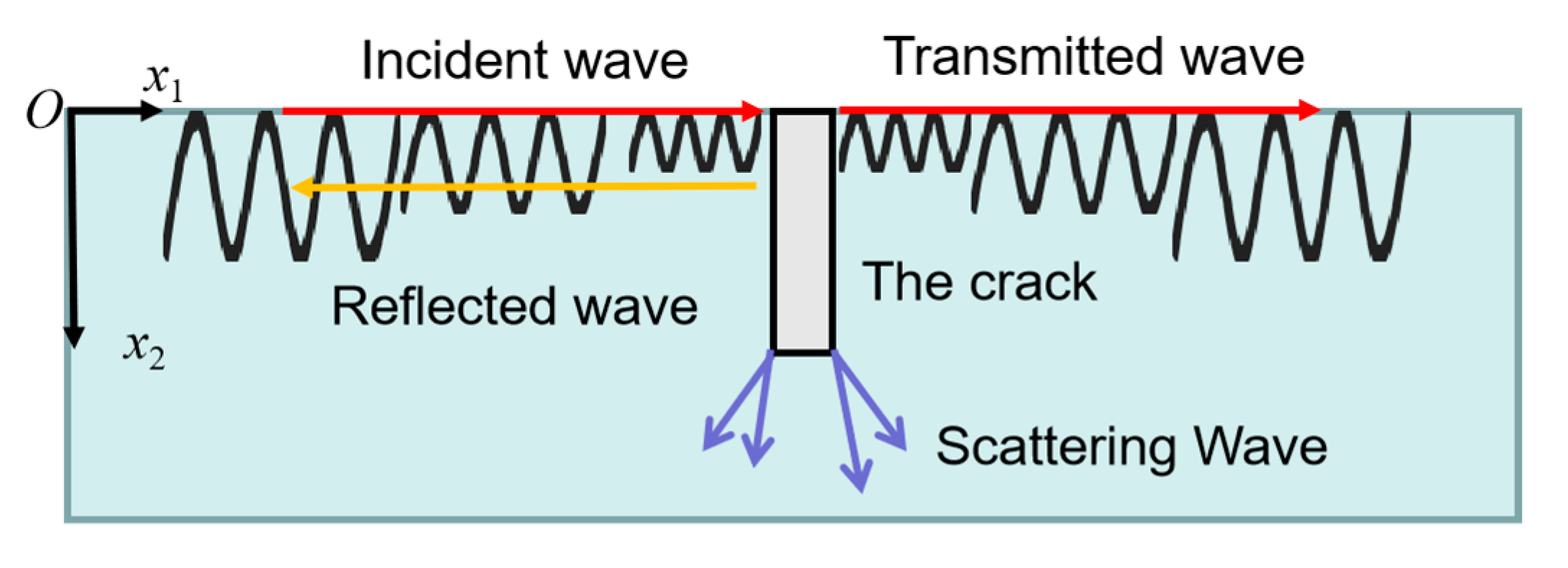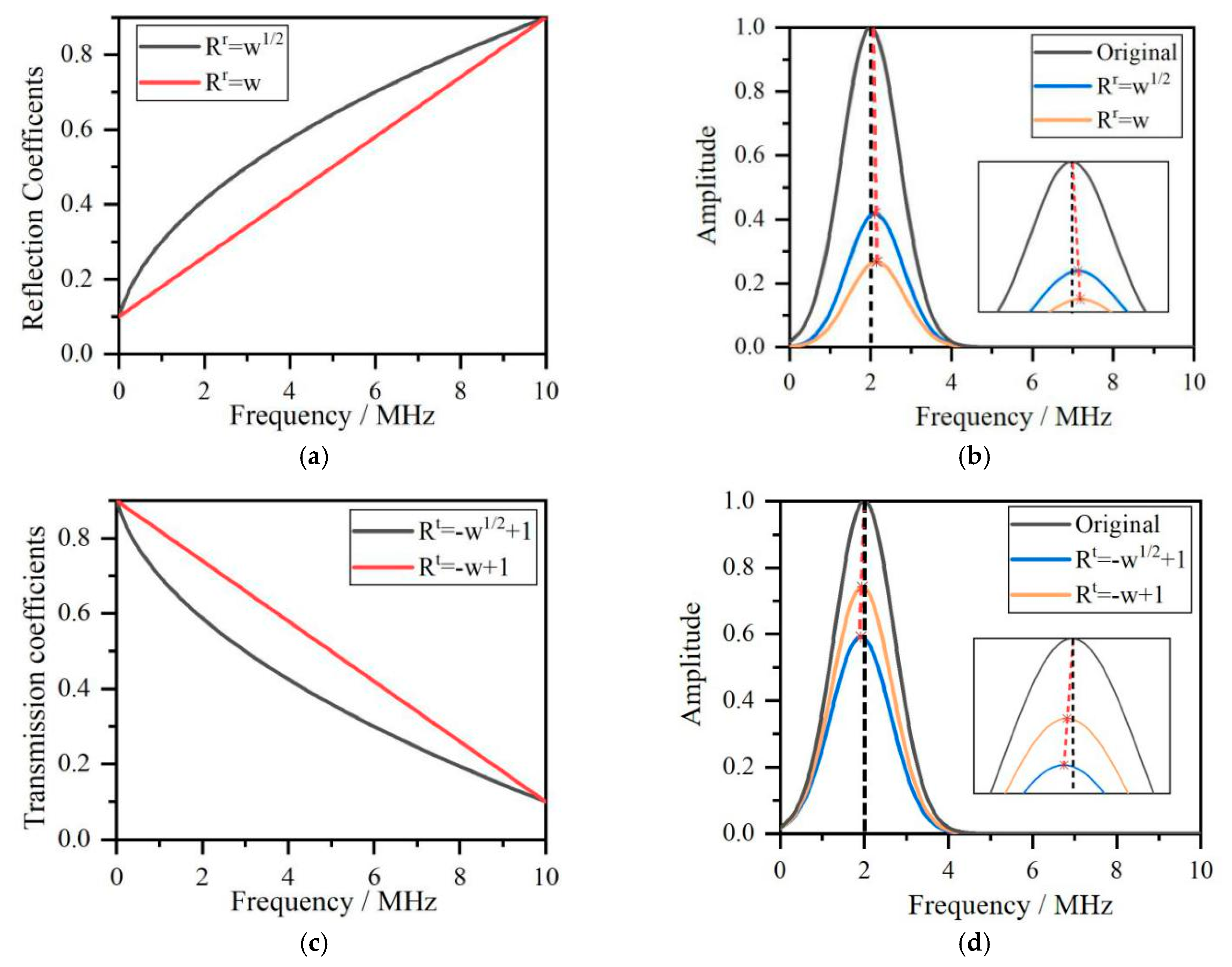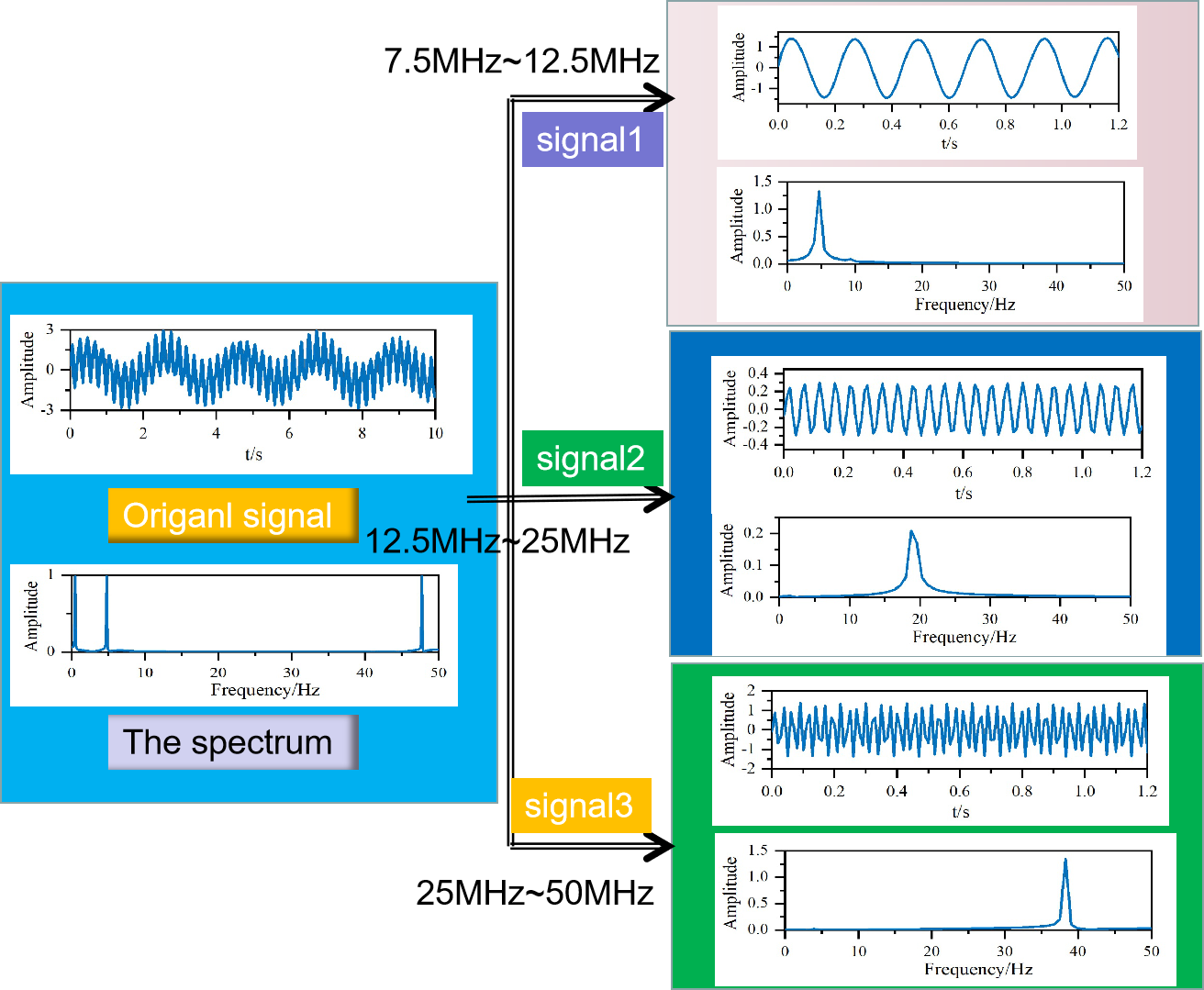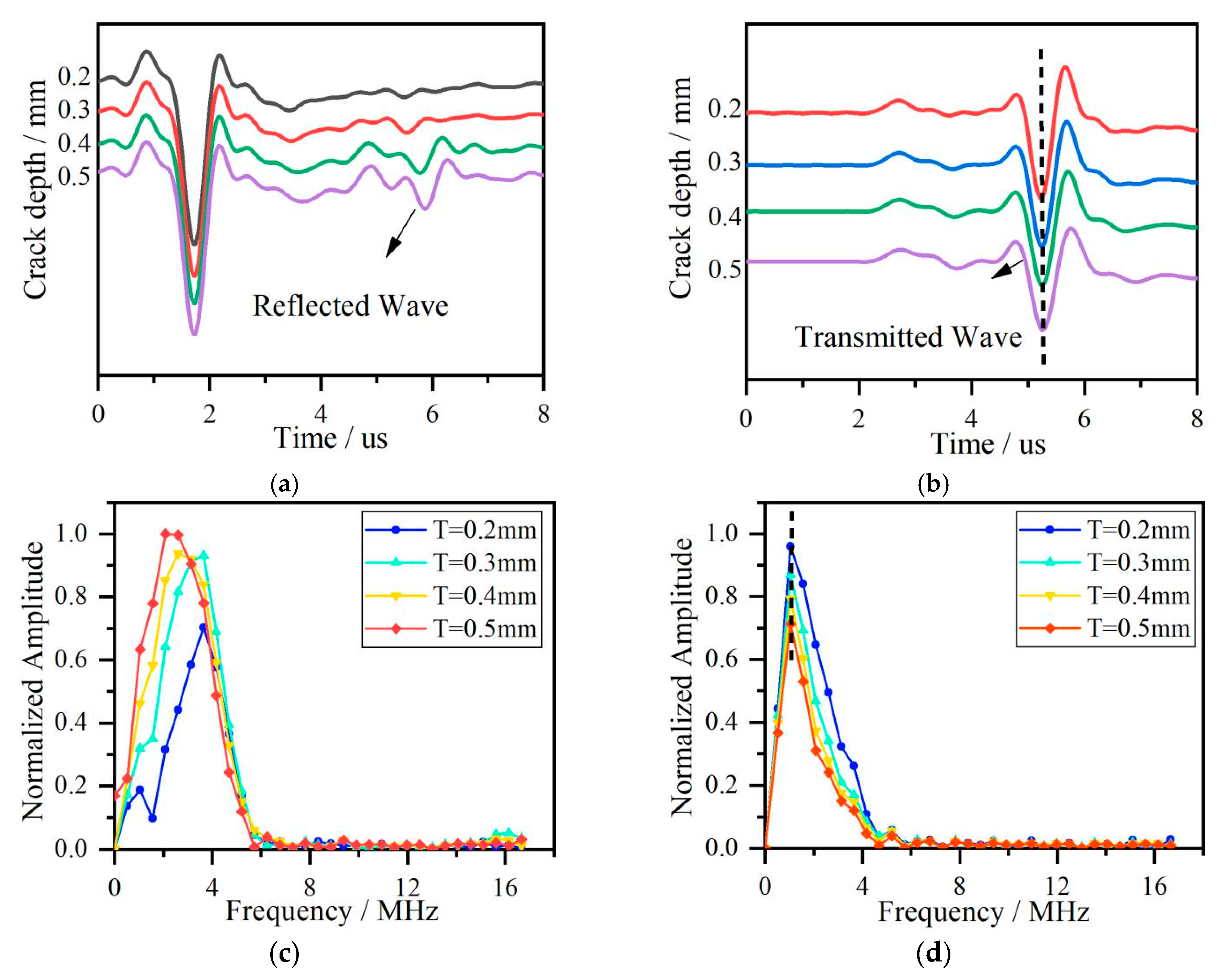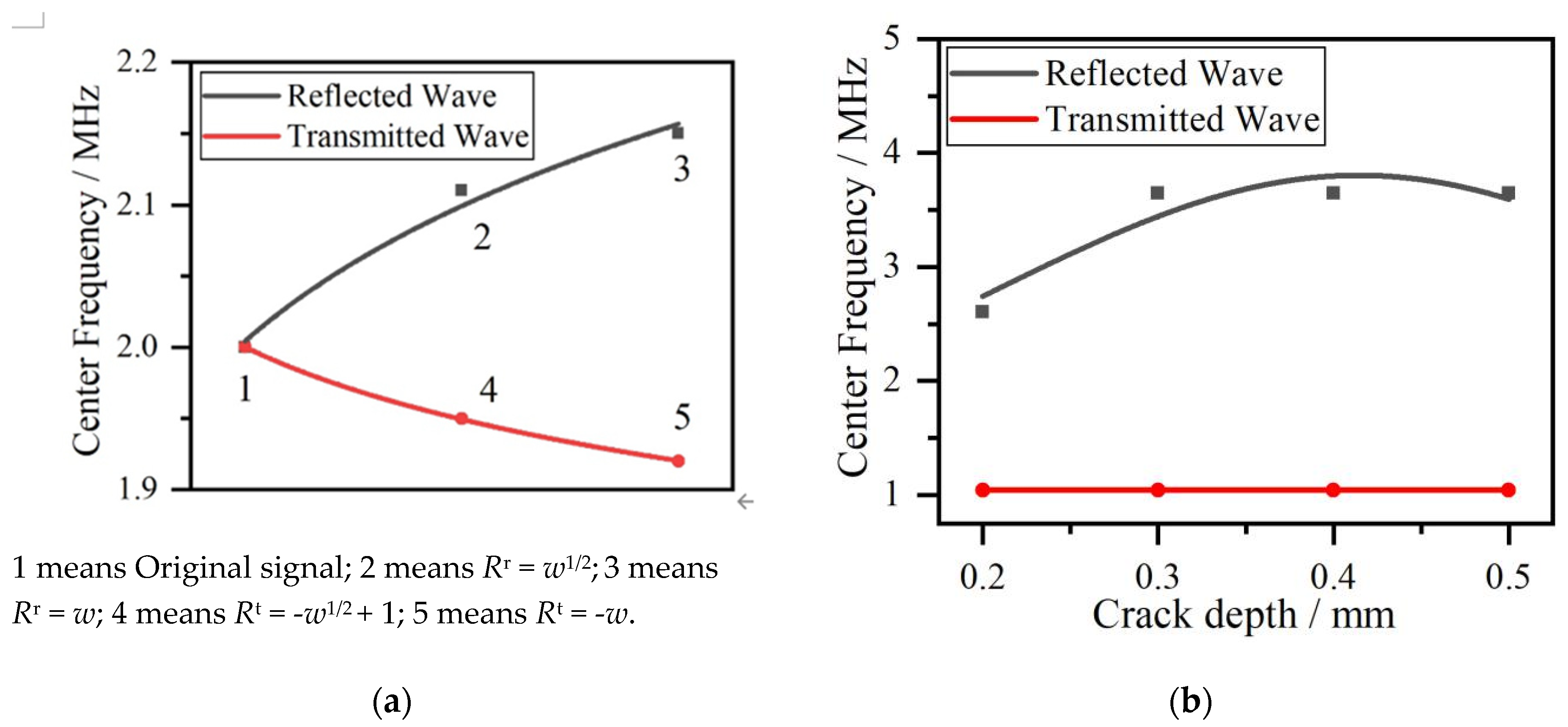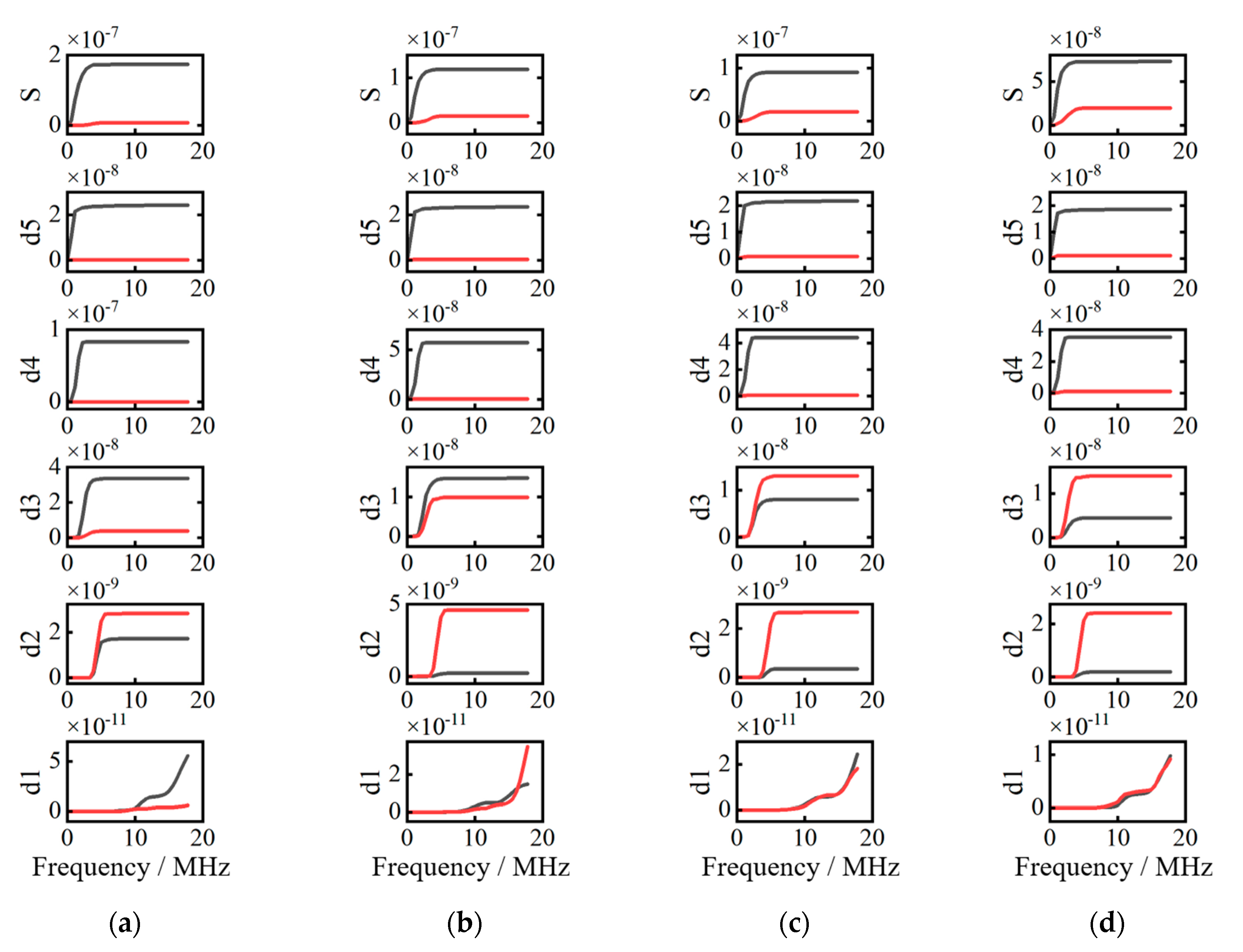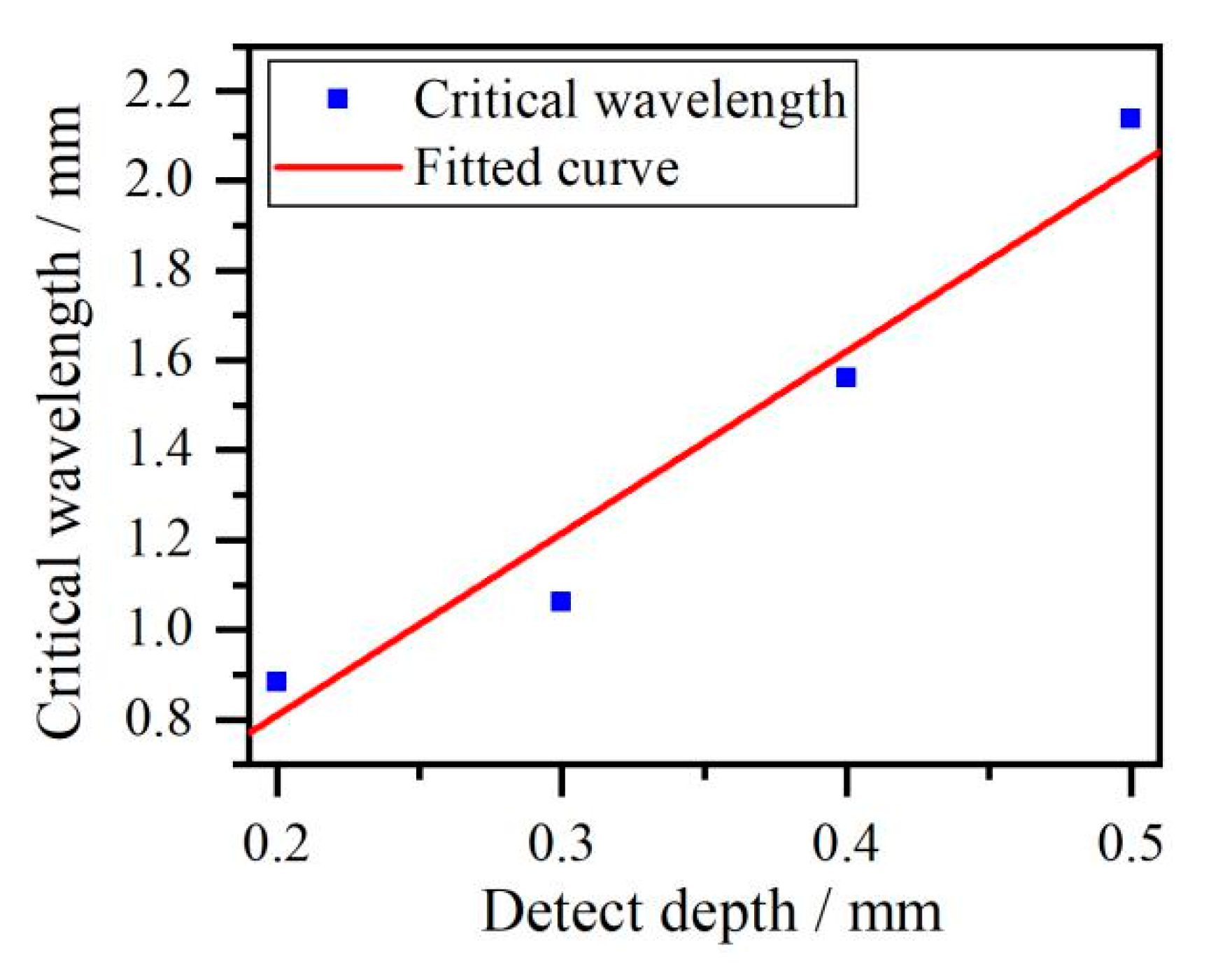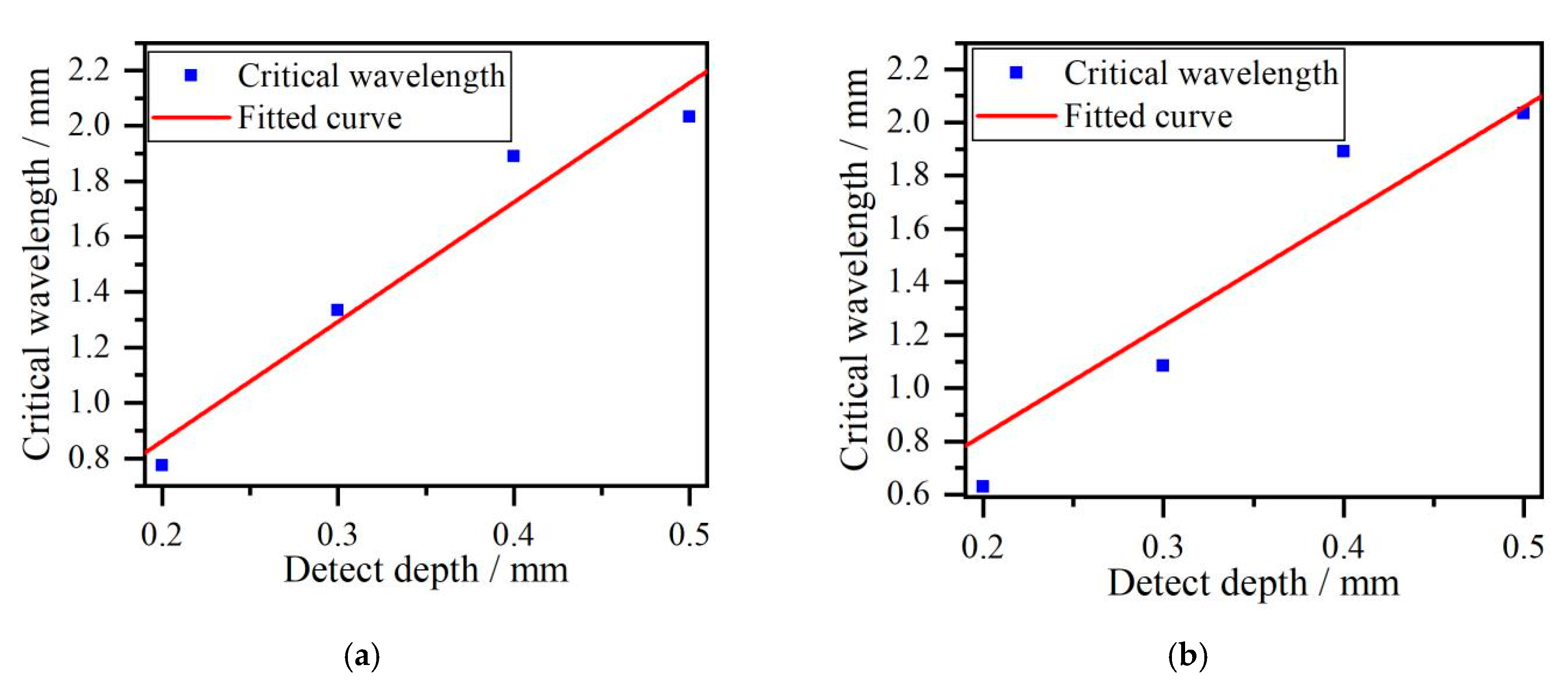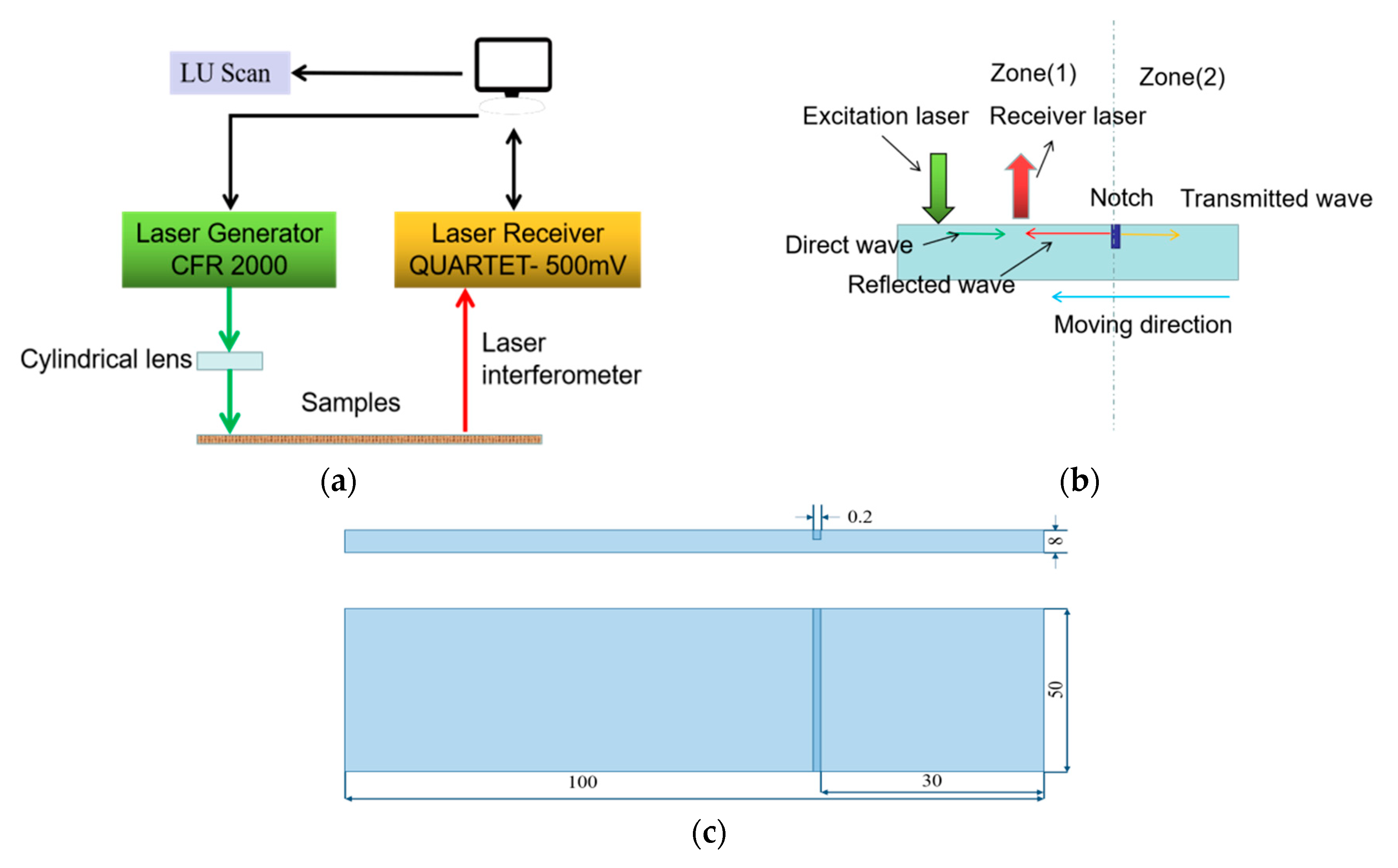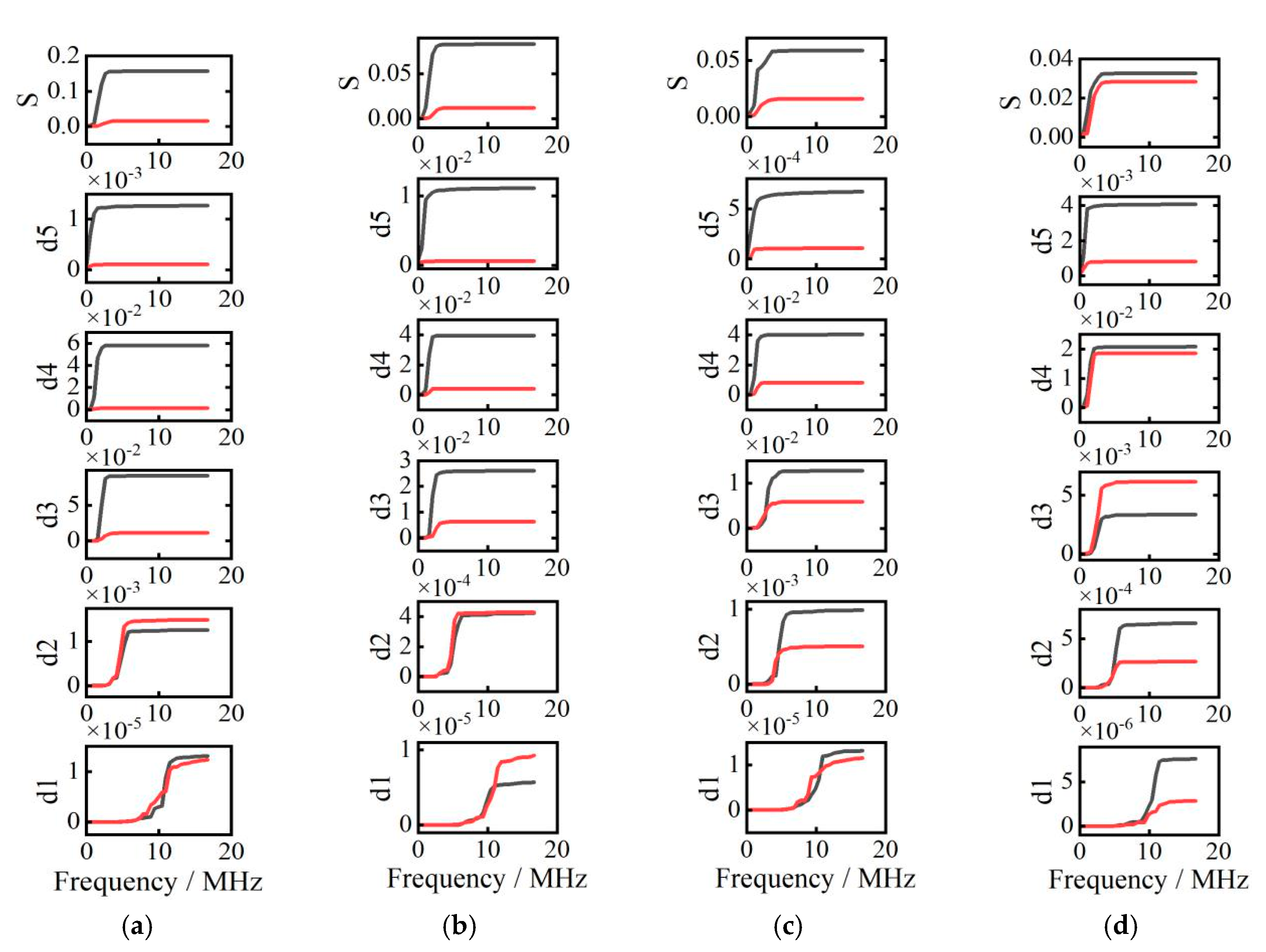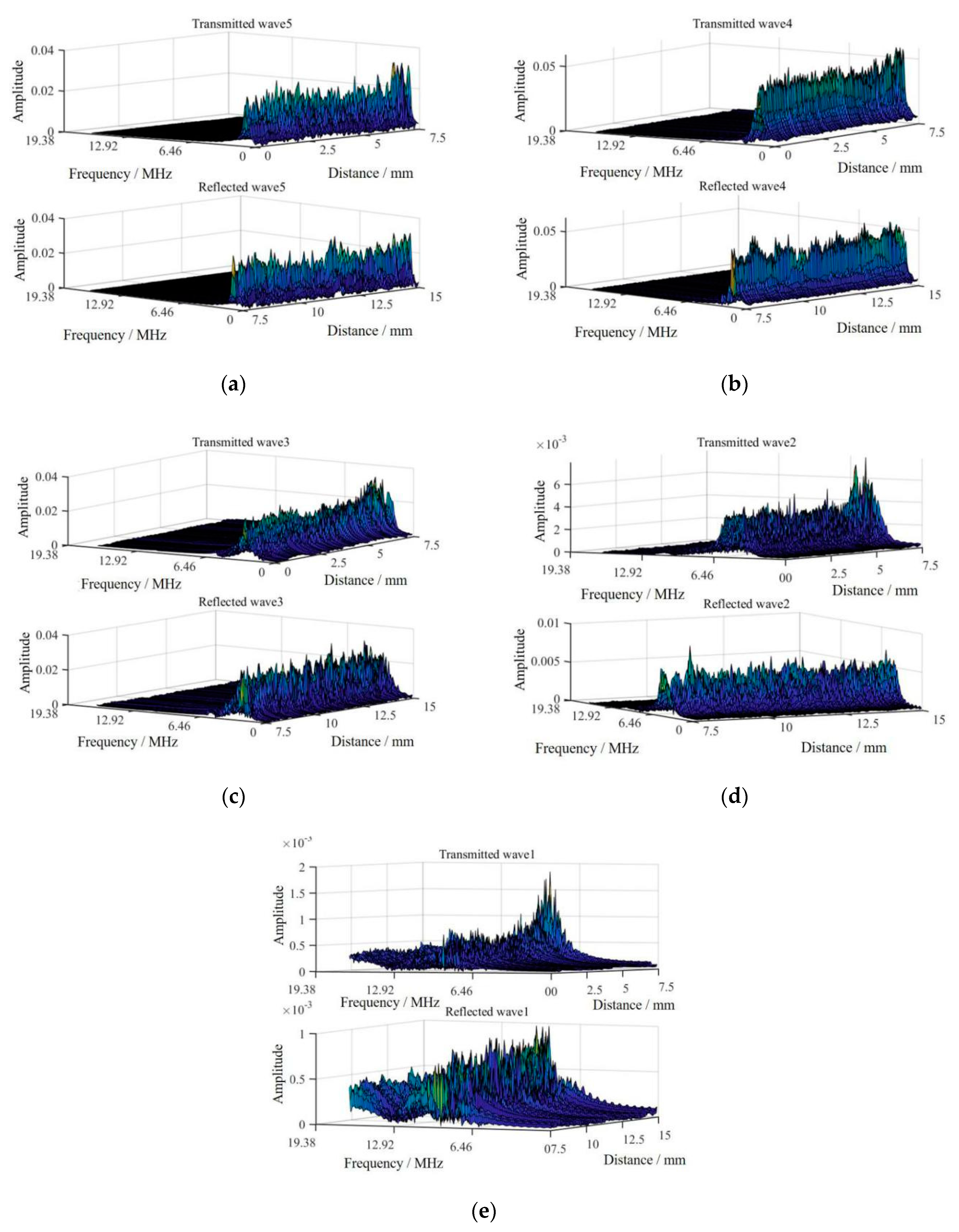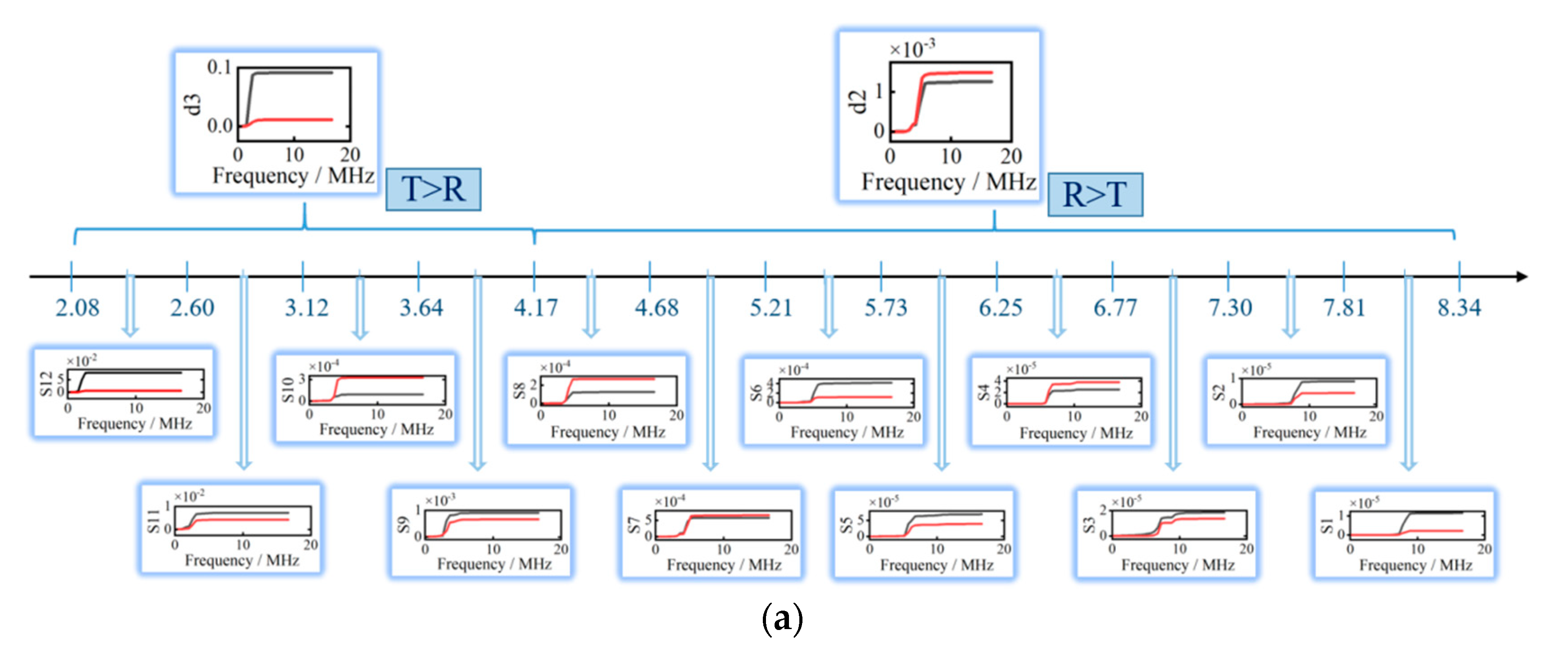1. Introduction
Without prompt detection, sub-wavelength surface cracks can develop into open and deep cracks, ultimately resulting in structural fracture failure. Quantitative determination of sub-wavelength surface cracks in the aerospace, aviation, and other fields is important to effectively evaluate mechanical properties. Rayleigh waves, whose energy penetration depth is approximately one wavelength during their propagation, are ideally suitable for detecting surface cracks, especially cracks with depths less than the incident Rayleigh wavelength.
The reflected, transmitted, and diffracted Rayleigh waves, whose time and frequency characteristics provide a substantial amount of crack size information, are generated by the interaction between the surface crack and the acoustic wave. During detection, contact transducers in the conventional detection technique are main method to generate and receive Rayleigh waves. Compared to incident wave wavelength, detected cracks are divided into two kinds that are long cracks with depths greater than at least one wavelength and sub-wavelength cracks whose depth is less than the incident wavelength. For the detection of long surface cracks, the pitch-catch [
1] and pulse-echo method [
2] which adopt the propagation characteristics of acoustic waves, reflection and transmission coefficients [
3] employing amplitude attenuation are usually applied. These linear acoustic theoretical methods work due to the fact the depth of the surface crack is deep enough leading to the propagating Rayleigh wave being seen as a ray. However, for sub-wavelength surface crack detection, a more complex measurement mechanism considering boundary condition of crack edge is adopted. Because the sub-wavelength crack dimensions are smaller than the elastic wavelength longitudinal component of the acoustic field generated by Rayleigh waves around crack surfaces parallel to the direction of propagation and approximately uniform and the other stress components are approximately equal to zero, Auld [
4] developed an analytical method based on reflection coefficients to estimate sub-wavelength surface crack sizes. Resch [
5] determined the actual acoustic parameters of transducers using an analytical equation in [
4] and experimentally applied this measurement method to infer crack depth, crack growth, and crack opening behavior during fatigue cycling. Subsequently, Hassan [
6] used finite element simulations to analyze the relationship between surface crack depth and reflection coefficients presented in [
4]. Based on a hypothesis in which surface cracks are considered energy absorbers when the crack depth satisfies a multiple of a half-wavelength long resulting in extreme points on the reflection coefficient vs. frequency curve, Domarkas [
7] proposed an analytical expression to estimate crack depth. In addition, a nonlinear interaction between Rayleigh wave and surface crack is simulated by Yuan [
8] using the finite element method to evaluate sub-wavelength crack depths. How a wave-amplitude and frequency-dependent response can be physically relevant for a certain frequency range is studied by [
9,
10]. Thus size detection of sub-wavelength cracks is a more complex problem due to the fact its size is smaller than the incident Rayleigh wave’s wavelength. For this reason, it is necessary to develop a new method combining both reflection and transmission Rayleigh waves for size detection of sub-wavelength cracks.
To overcome the limitations of the detection environment and specimen size due to the fact traditional measurement methods are dependent on contact transducers for acoustic signal generation and detection, Rayleigh waves based on ultrasonic laser with high resolution, wide broadband, and non-contact detection have been developed to investigate surface cracks [
11,
12,
13,
14,
15,
16]. In these publications, the characteristics of reflected and transmitted Rayleigh waves at cracks are analyzed to accurately evaluate crack depth. Cooper [
11] and Hess [
12] investigated reflection and transmission Rayleigh waves at surface cracks. Using the frequency spectrum of reflection and transmission acoustic waves, Cooper studied the effect of surface cracks on the frequency spectrum and arrival time of reflection and transmission Rayleigh waves. Finally, he created a crack depth evaluation methodology using the arrival time of reflected Rayleigh waves and mode-converted transverse waves at the base of cracks. Hess adopted an experimental design of generation and reception positions at a fixed distance to detect surface cracks. The reflection coefficient function based on reflection waves and the time of flight based on transmission waves were compared to acquire acoustic wave signals in different zones on two sides of cracks. At the singular tip of cracks, scattering waves and mode conversion at the cracks were observed by simulation and experimental methods in the time domain to estimate surface crack depth [
11,
13,
14]. A conformal mapping method that solves the limitation of incident wavelength and distance is proposed to evaluate crack depth using the transmitted Rayleigh waves [
15]. Taking into account the contact interface stiffness of closed cracks, Lomonosov [
16] applied the reflection coefficient function with respect to frequency of Rayleigh wave based on ultrasonic laser to estimate the size of closed surface cracks. For an artificial surface crack, Zhou [
17] pointed out that the transmission coefficients of Rayleigh waves generated by laser at crack are dependent on their frequency range. The sensitivity and reliability of crack depth characterization is controlled by the Rayleigh wave wavelength and bandwidth using an ultrasonic laser to generate and detect Rayleigh waves. Tournat [
18] investigated a nonlinear mixed frequency method to quantitatively evaluate crack depth by using two waves generated by a laser having low and high frequency leading to a more sensitive image for crack achieved. In addition, a near field method called Scanning Laser Source has been extensively studied by lots of researchers [
19,
20,
21]. In this method, the arrival time of a Rayleigh wave and its scattering waves are analyzed to calculate for crack depth evaluation when the incident laser just impacts on the crack. Overall, most obtained achievements focus on long crack detection and few studies on the sub-wavelength surface crack detection are developed using Rayleigh waves based on lasers.
A quantitative determination method for sizing sub-wavelength surface cracks by the threshold phenomenaon’s critical frequency is proposed in this study. A broadband Rayleigh wave is the combined result of individual components with different frequencies, whose energy is concentrated on the surface medium in one wavelength of each component. When they encounter a crack during their propagation, low-frequency acoustic waves more easily travel through the crack, while high-frequency acoustic waves are more likely be reflected [
12]. Due to the different reflection and transmission capacities of individual components in a range of broadband frequencies, a threshold phenomenon of energy transformation of reflection and transmission Rayleigh waves in the frequency domain is analyzed. Above the threshold phenomenon’s critical frequency, the energy of reflection Rayleigh wave is greater than that of the transmission Rayleigh wave during acoustic scattering at the crack. However, below the threshold phenomenon’s critical frequency, the energy of reflection Rayleigh wave is less than that of the transmission Rayleigh wave. The threshold phenomenon’s critical frequency is related to crack depth. In the theoretical part, a Gaussian function is employed to describe the modulation of crack size on the reflection and transmission coefficients. Both amplitude reduction and center frequency shift are observed in the frequency spectrum. Using the finite element method (FEM), the acoustic field including the reflection and transmission Rayleigh wave at surface crack is obtained. Using the wavelet transform and Parseval’s theorem, critical frequencies at cracks with different depth are recorded by analyzing reflection and transmission Rayleigh waves in the frequency domain. A fitted curve with a slope of close to 4 is obtained by critical wavelength vs. crack depth. The crack depth is successfully estimated using threshold phenomenon’s critical frequencies. The experimental results of tests conducted on artificial notches agree with the simulation results. Finally, a discussion and summary conclude this paper.
6. Conclusions
Rayleigh waves based on lasers are broad band acoustic waves which contain a great deal of individual components with different frequencies. When they meet a surface crack the individual components display different ability to reflect and transmit at the crack. The modulation of surface crack size on the frequency spectrum of acoustic wave is theoretically analyzed by Gauss and power functions.
A threshold phenomenon related with the ratio of incident wavelength and crack depth exists in the frequency spectrum due to the comprehensive interaction of all frequency components and the surface crack. The critical wavelength of threshold phenomenon related to crack depth has potential to evaluate crack depth.
The wavelet transformation and Parseval’s theorem are adopted to analyze reflection and transmission Rayleigh waves and obtain the critical frequency. Finally, both the simulation and experimental results show that the ratio of critical wavelength of threshold phenomenon to crack depth is close to the value of 4. Owing to this relationship, the critical frequency method using Rayleigh waves based on laser is proposed to size depth of sub-wavelength surface crack.
